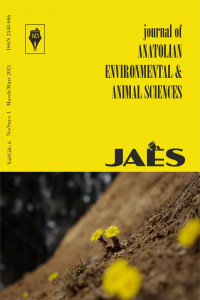Effect of Different Feeding Materials on the Trace and Nutrient Elements of Vermicompost using Eisenia fetida
Abstract
The aim of this study was to determine the influences of different feeding materials on the physico-chemical parameters of vermicompost using Eisenia fetida. In this study, four treatments, with the same conditions in terms of organic wastes type were prepared to produce vermicompost from hazelnut husk (% 100), tea plant waste (%100), hazelnut husk (A) (% 50) + tea plant waste (B) (50%), hazelnut husk (A) (30%) + tea plant waste (30%) + cow dung (20%) + sawdust (15%) + waste newspaper (%5) using earthworms. The standard laboratory analysis methods were used to determine the physical and chemical parameters in the different produced vermicomposts. The mean N content in the growing medium A, B, C, and D was 1,41%, 2,5%, 1,96%, and 1,47% respectively. The mean phosphorus content in the growing medium A, B, C, and D was 807,69 mg/kg, 1748,25 mg/kg, 1491,25 mg/kg, and 1410,75 mg/kg respectively. The mean potassium in the growing medium A, B, C, and D was 11244,69 mg/kg, 7790 mg/kg, 6884,25 mg/kg, and 8006,25 mg/kg respectively. Compared to the initial vermibed mixture, the N, P, and K content was higher in all the growing mediums. The Pb, Cd and As content was lower in all the growing mediums in the final compost than the initial vermibed mixture. Eisenia fetida is very effective in converting some waste materials into high-quality compost and decreasing the heavy metal content in the final vermicompost more than in the initial vermibed mixture.
Keywords
Supporting Institution
Recep Tayyip Erdoğan University Scientific Research Coordinator (with the Project number 2014.113.01.01 (ID=253)) and LAZUTİM, Organic Agriculture, Livestock, Food, Trade Company.
Project Number
Recep Tayyip Erdoğan University Scientific Research Coordinator
Thanks
I would like to express my gratitude to Dr. Filiz Yüksek and Kerem Yiğit Yüksek for their assistance with the experimental work in the laboratory. The author gratefully acknowledges the Recep Tayyip Erdoğan University Scientific Research Coordinator (with the Project number 2014.113.01.01 (ID=253)) and LAZUTİM, Organic Agriculture, Livestock, Food, Trade Company.
References
- Referans 1 : Abassi, S.A., Nayeem-Shah, M.& Abassi, T. (2015). Vermicomposting of phytomass: limitations of the past approaches. Journal of Cleaner Production, 93, 103-114. DOI:10.1016/j.jclepro.2015.01.024
- Referans 2: Adi, A.J. & Noor, Z.M. (2009). Waste recycling: Utilization of coffee grounds and kitchen waste in vermicomposting. Bioresource Technology, 100, 1027–1030. DOI: 10.1016/j.biortech.2008.07.024
Farklı besleme materyallerinin Eisenia fetida kullanılarak oluşturulan vermikomposttaki bazı besin elementleri ve ağır metal değişimine etkisi
Abstract
Bu çalışmanın amacı, farklı besleme materyalleri ile Eisenia fetida’nın beslenmesi sonucunda oluşan vermikomposttaki bazı fiziko-kimyasal parametrelerin tespit edilmesidir. Bu amaçla, fındık kabuğu (A) (%100), çay bitkisi atığı (B) (%100), fındık kabuğu (C) (%50) + çay atığı (%50), (D)fındık atığı (%30) +çay atığı (%30) +inek gübresi (%20) +talaş (%15) + atık kağıt (%5) oluşan besi ortamlarında rastgele yönteme göre dört tekrarlı denemeler kurulmuştur. Araştırma sonucunda elde edilen vermikomposttaki bazı fiziko-kimyasal parametreler standart laboratuvar testleri ile tespit edilmiştir. Araştırma sonucunda A, B, C ve D yetiştirme ortamlarından elde edilen ortalama N içeriği sırasıyla %1,41, %2,5, %1,96 ve %1,47 dir. A, B, C ve D yetiştirme ortamındaki ortalama fosfor içeriği sırasıyla 807,69 mg/kg, 1748,25 mg/kg, 1491,25 mg/kg ve 1410,75 mg/kg’dır. Vermikomposttaki Pb, Cd ve As içeriği, tüm yetiştirme ortamlarında başlangıçtaki besi ortamına kıyasla daha düşük seviyede olduğu ortaya konulmuştur. Eisenia fetida’nın bazı atık maddelerin yüksek kaliteli kompost haline dönüştürülmesinde ve son vermikomposttaki ağır metal içeriğinin azalmasında etkili olduğu tespit edilmiştir
Anahtar Kelimeler: Ağır metal, çay atığı, Eisenia fetida, fındık atığı, atık kağıdı
Keywords
Project Number
Recep Tayyip Erdoğan University Scientific Research Coordinator
References
- Referans 1 : Abassi, S.A., Nayeem-Shah, M.& Abassi, T. (2015). Vermicomposting of phytomass: limitations of the past approaches. Journal of Cleaner Production, 93, 103-114. DOI:10.1016/j.jclepro.2015.01.024
- Referans 2: Adi, A.J. & Noor, Z.M. (2009). Waste recycling: Utilization of coffee grounds and kitchen waste in vermicomposting. Bioresource Technology, 100, 1027–1030. DOI: 10.1016/j.biortech.2008.07.024
Details
| Primary Language | English |
|---|---|
| Journal Section | Articles |
| Authors | |
| Project Number | Recep Tayyip Erdoğan University Scientific Research Coordinator |
| Early Pub Date | June 16, 2022 |
| Publication Date | June 30, 2022 |
| Submission Date | January 19, 2022 |
| Acceptance Date | March 15, 2022 |
| Published in Issue | Year 2022 Volume: 7 Issue: 2 |
Cited By




